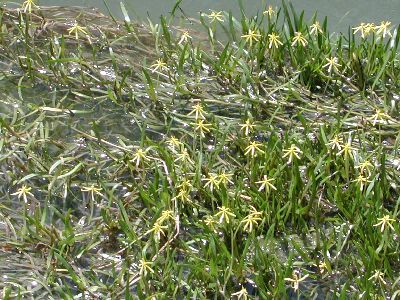
Ecological Importance
Water Stargrass is an important food for geese and ducks including northern pintail, blue winged teal and weed ducks. It also offers cover and foraging opportunities for fish.
Problems
Water stargrass generally does not cause issues in Wisconsin where naturally growing unless nutrient loading and sunlight penetration is increased. When these conditions occur water stargrass can readily cover the bottom of lakes, ponds and rivers producing dense stands which cover traditional fish spawning beds.
Plant Description:
Water stargrass is grass-like with thin branching dark-green stems and alternate leaves with no prominent midvein. Water star grass can grow up to 6 feet long and can form floating colonies.
Flowers rise above the surface and are bright yellow, star-shaped, with 6 narrow petals. Water stargrass reproduces from seeds and through fragmentation. A slender, multi-branched stem grows from the buried rhizome. Alternate leaves and a rounded stem can help distinguish from flat-stem pondweed. Distinctive yellow, star-shaped flowers provides basis for its common name.
Hints to Identify
Water stargrass has grass-like leaves with no distinct midvein. In summer, water stargrass produces yellow star-like flowers that protrude above the water surface

Common Application Questions
Q. How much should I treat?
A. Spot treat as needed to maintain navigation channels and swimming areas. Remember this plant is very beneficial and should not be treated where it is not a nuisance.
Q. When is the best time to treat?
A. Once water temperatures are around sixty degrees or warmer and/or the plant is actively flowering. Water Star grass responds equally well to herbicide treatment when mature.
Q. How often do I need to treat Water Stargrass?
A. Generally one to two treatments per season is enough.
Q. How long before I see results?
A. Generally within 12 - 16 days things will be cleared up.
| Homeowner Treatment Options |
| Aquathol K |
| Aquathol Super K |
| Hydrothol® Granular |
| Sonar RTU |
| *Aquatic Biologists recommends implementing preventative management techniques and physical removal prior to, or in conjunction with treatment. |
